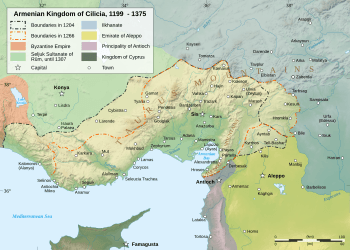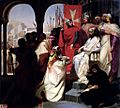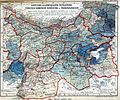Armenian Kingdom of Cilicia facts for kids
Quick facts for kids
Armenian Kingdom of Cilicia
Կիլիկիոյ Հայոց Թագաւորութիւն
|
|||||||||||||
|---|---|---|---|---|---|---|---|---|---|---|---|---|---|
| 1198–1375 | |||||||||||||
 |
|||||||||||||
| Capital | Tarsus (first capital), Sis | ||||||||||||
| Common languages | Armenian (native language), Latin, Old French | ||||||||||||
| Religion | Armenian Apostolic Church | ||||||||||||
| Government | Monarchy | ||||||||||||
| Historical era | Middle Ages | ||||||||||||
|
• Leo I of Armenia [I] becomes the first King of Armenian Cilicia.
|
January 6 1198 | ||||||||||||
|
• tributary to the Mongols
|
1236 | ||||||||||||
|
• Sis is conquered by the Mamluks, putting an end to the kingdom.
|
1375 | ||||||||||||
|
|||||||||||||
|
Although the kingdom was established on 1198, its foundations were laid in 1080 by Ruben I when the Rubenid principality of Cilicia was founded.
|
|||||||||||||
The Armenian Kingdom of Cilicia was an important country that existed a long time ago, during the Middle Ages. It was founded by Armenian people who had to leave their homes because of invasions. This kingdom was located near the Mediterranean Sea, in an area that is now southern Turkey. It was an independent country for many years, from about 1078 to 1375.
Contents
A Kingdom in the Middle Ages
The Armenian Kingdom of Cilicia was a strong and independent state. It was created by Armenians who were escaping attacks from the Seljuks. The Seljuks were a powerful group from Central Asia. The kingdom was founded around 1078. It became a full kingdom in 1198.
Where Was Cilicia?
The kingdom was located in a region called Cilicia. This area is in what is now southern Turkey. It was an important place because it was near the Mediterranean Sea. This location helped the kingdom trade with other countries.
How the Kingdom Started
The kingdom's beginnings were laid by Ruben I in 1080. He started a small Armenian principality. Over time, this small state grew stronger. In 1198, Levon I became its first king. This made it a recognized kingdom.
The End of the Kingdom
The Armenian Kingdom of Cilicia lasted for many years. However, it faced many challenges. In 1375, the city of Sis, which was the capital, was conquered. It was taken over by the Mamluks, a powerful group from Egypt. This event marked the end of the kingdom.
Allies During the Crusades
The Armenian Kingdom of Cilicia played a big role during the Crusades. The Crusades were a series of religious wars. They happened between Christians and Muslims in the Middle East. The Armenians were very important allies for the Crusaders.
Helping the Crusaders
Many Armenian soldiers joined the Crusader armies. They were known for being brave and skilled fighters. In the early 12th century, many Armenian fighters were available to help. They were a key part of the local troops.
A Special Offer
One powerful Armenian prince was named Thoros II. He made an amazing offer to the King of Jerusalem. Thoros II offered to send 30,000 Armenian warriors. These warriors would come with their families. They would move to the Kingdom of Jerusalem.
King Thoros of Armenia proposed that King Amalric of Jerusalem evict the Saracen peasants of his realm and replace them with 30,000 trustworthy Armenian warriors, who would come with their families to populate and defend the country.
This offer showed how much the Armenians wanted to help. They wanted to protect the Christian lands. The king and his nobles were very interested in this idea.
Related pages
Images for kids
-
Situation in the Armenian highlands during the Seljuk Empire.
-
Baldwin of Boulogne receiving the homage of the Armenians in Edessa.
-
Ghazan ordering the King Of Armenia Het'um II to accompany Kutlushah on the 1303 attack on Damascus.
-
Constantin III of Armenia on his throne with the Hospitallers. "Les chevaliers de Saint-Jean-de-Jerusalem rétablissant la religion en Arménie", 1844 painting by Henri Delaborde.
-
Cilicia, particularly Kozan sanjak of Adana Vilayet, retained a substantial Armenian population until the Armenian genocide.
-
An illuminated manuscript of John the Apostle by Toros Roslin completed in 1268.
See also
 In Spanish: Reino armenio de Cilicia para niños
In Spanish: Reino armenio de Cilicia para niños
















